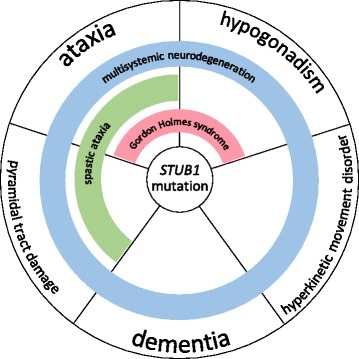Fig. 3.

The unfolding phenotypic spectrum of STUB1 disease. The clinical spectrum of STUB1 mutations unfolds along five different neurological key features: ataxia, pyramidal tract damage, dementia, hypogonadism, and hyperkinetic movement disorders. Accordingly, each or several of these key features might be missing in single individuals with STUB1 disease. Moreover, it illustrates that STUB1 causes ataxia and hypogonadism (=Gordon Holmes syndrome) not in isolation, but as part of a continuous spectrum of STUB1-associated disease features. These features can be variably combined in STUB1-disease clusters, e.g. ataxia and hypogonadism (red bar ≙ Shi et al. [5]), ataxia with pyramidal tract damage (spastic ataxia; green bar ≙ Synofzik et al. [1]), or ataxia plus hypogonadism, pyramidal tract damage, dementia and hyperkinetic movement disorders, i.e. encompassing all STUB1 disease features (blue bar ≙ current report)
